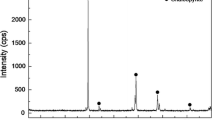Abstract
The process for extraction of hydrogen cyanide to decontaminate solutions produced at cyaniding of sulfide flotation concentrates is developed. The centrifugal-bubbling apparatus is employed as a reactor. The regularities of HCN formation in an acid medium are established in investigation into kinetics of SCN− thiocyanate oxidation by hydrogen peroxide H2O2 in presence of Fe2+, Fe3+ and pH ≤ 3.5. In the process proposed the evolved HCN is adsorbed by NaOH solution and returned to the circuit of leaching of gold and silver as NaCN, and the waste cyaniding solution is discharged into a waste dump, where it is mixed with industrial water to be utilized to transport flotation tailings.
Similar content being viewed by others
References
Terry I. Mudder, “Cyanide recycling process,” U.S. Pat. No. 5 254 153, Oct. 19 (1993).
P. A. Riveros and D. Coren, “Cyanide recovery from a gold mill barren solution containing high levels of copper,” CIM Bull., 91/1025 (1998).
A. A. Kochanov, A. A. Ryazantsev, A. A. Batoeva, et al., “Extraction of cyanides from waste solutions from cyaniding of flotation concentrates of Kholbinsk gold deposit,” Khim. Int. Ust. Razv., No. 12 (2004).
I. R. Wilson and M. Harris, “The oxidation of thiocyanate by hydrogen peroxide. Part II. The acid catalyzed reaction,” J. Am. Chem. Soc., 83 (1960).
J. N. Figlar and D. M. Stanbury, “Thiocyanogen as an intermediate in the oxidation of thiocyanate by hydrogen peroxide in acidic aqueous solution,” Inorg. Chem., 39 (2000).
J. J. Barnett, M. L. McKee, and D. M. Stanbury, “Acidic aqueous decomposition of thiocyanogen,” Inorg. Chem., 43 (2004).
M. Lahti, L. Viipo, and Jari Hovinen, “Spectrophotometric determination of thiocyanate in human salvia,” J. Chem. Ed., 76, No. 9 (1999).
Yu. Yu. Lurier and A. I. Rybnikova, Chemical Analysis of Industrial Waste Waters [in Russian], Khimiya, Moscow (1974).
C. Walling, “Fenton’s reagent revisited,” Acc. Chem. Res., No. 8 (1975).
A. Ya. Sychev and V. G. Isak, “Compounds of iron and mechanisms for homogenous catalysis of activation of O2, H2O2 and oxidation of organic substrates,” Usp. Khim., No. 64 (1995).
S. H. Bossmann, E. Oliveros, S. Golb, et al., “New evidence against hydroxyl radicals as reactive intermediates in the thermal and photochemically enhanced Fenton reactions,” J. Phys. Chem., A 102 (1998).
A. A. Kachanov, A. A. Ryazantsev, and A. A. Batoeva, “Intensification of mass-exchange processes in neutralization of technological solutions of cyanidization,” JOMI, No. 4 (2002).
A. A. Ryazantsev, A. A. Asalkhanova, A. A. Batoeva, et al., “RF Patent No. 2310614. Process for decontamination of cyanide- and rhodanite-bearing waste waters,” Byull. Izobret., No. 32 (2007).
Author information
Authors and Affiliations
Corresponding author
Additional information
__________
Translated from Fiziko-Tekhnicheskie Problemy Razrabotki Poleznykh Iskopaemykh, No. 1, pp. 98–105, January–February, 2009.
Rights and permissions
About this article
Cite this article
Prosyanikov, E.D., Tsybikova, B.A., Batoeva, A.A. et al. Extraction of hydrogen cyanide from waste solutions of cyaniding circuit for sulfide flotation concentrates. J Min Sci 45, 80–86 (2009). https://doi.org/10.1007/s10913-009-0010-0
Received:
Published:
Issue Date:
DOI: https://doi.org/10.1007/s10913-009-0010-0




